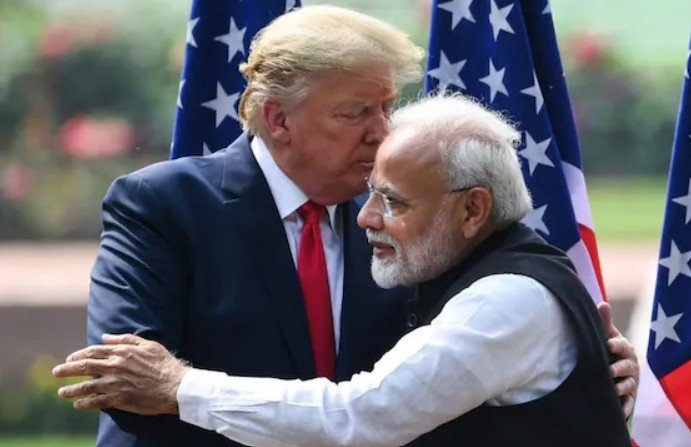INA — News Desk
Modi–Trump Exchange Signals Thaw
Despite high tariffs and sharp rhetoric over Russian oil, both leaders project resilience in their personal bond and reaffirm a forward-looking strategic partnership.
Relations between India and the United States showed signs of easing this weekend after Prime Minister Narendra Modi publicly reciprocated U.S. President Donald Trump’s remarks praising their personal rapport. The statements came just days after Washington raised tariffs on Indian exports to 50 percent, suggesting both sides are seeking to protect political ties despite escalating trade and energy disputes.
US Tariffs on Indian Goods (2025)
50% ┃■■■■■■■■■■■■■■■■■■■■■■■■■■■■■■
25% ┃■■■■■■■■■■■■
10% ┃■■■■
0% ┃
Baseline Aug 2025 Late Aug 2025
Caption: U.S. tariffs on Indian goods rose from a baseline of about 10% to 25% in early August, and then doubled to 50% by late August. The steep increase amplified tensions between Washington and New Delhi.
India–US relations have entered another phase of sharp contradictions—marked by tariffs, accusations, and mixed messaging, yet underscored by signals of personal warmth between Prime Minister Narendra Modi and U.S. President Donald Trump. In the first public exchange since Washington imposed a 50 percent tariff on Indian exports, both leaders stressed their enduring friendship, with Modi “fully reciprocating” Trump’s sentiments. The statements suggest an attempt to keep the partnership steady even as geopolitical and trade frictions intensify.
Timeline of the Recent Tensions
| Date | Event | Significance |
|---|---|---|
| August 2025 | Trump announces a 25% tariff on Indian goods | Triggered by India’s continued oil imports from Russia |
| Late August 2025 | Additional 25% tariff imposed, raising duty to 50% | India calls it “unjustified and unreasonable” |
| 1 Sept 2025 | Trump labels US–India trade ties “one-sided disaster” | Signals deep frustration |
| 5 Sept 2025 | Trump softens stance, calls Modi a “great prime minister” and a “friend” | Marks return of personal warmth |
| 6 Sept 2025 | Modi responds on X, “fully reciprocating” Trump’s remarks | Reaffirms Comprehensive Global Strategic Partnership |
Visual Explainer: Tariffs Impact on Indian Exports
Figure 1: Escalation of US Tariffs on Indian Exports in 2025
Tariff Rate (%)
│
50 ────────────────■───────────────
40
30 ───────■────────
20
10 ──■─────────────
┌───┬───────┬───────┬───────┐
Baseline Aug 2025 Late Aug 2025 Sept 2025
The chart shows how tariffs escalated from a baseline of around 10% to 25% in early August, doubled to 50% by late August, and remained in force through September 2025. This sharp increase amplified trade tensions and uncertainty for Indian exporters.Modi’s Response
Prime Minister Modi’s message on X emphasized continuity despite friction. He wrote that he “deeply appreciates and fully reciprocates President Trump’s sentiments,” and underlined that India and the United States share a “positive and forward-looking Comprehensive and Global Strategic Partnership.” Modi’s words were calibrated: acknowledging Trump’s personal remarks while anchoring India’s strategic posture in institutional terms.
Trump’s Mixed Messaging
President Trump’s comments have oscillated between confrontation and conciliation.
- Criticism of India’s oil imports from Russia: Trump accused India of undermining U.S. sanctions and justified tariffs as a punitive measure.
- Accusations of trade imbalance: Earlier, Trump described the relationship as a “totally one-sided disaster.”
- Affirmation of friendship: In his latest remarks, however, he called Modi “a great prime minister” and stressed they would “always be friends.”
This fluctuation reflects both Trump’s transactional style of diplomacy and the larger U.S. frustration with India’s assertion of strategic autonomy.
Strategic Autonomy and Energy Security
India has consistently defended its decision to continue Russian oil purchases. Officials argue that discounted imports are essential for national energy security and economic stability. By refusing to align completely with U.S. sanctions, New Delhi has reaffirmed its doctrine of multi-alignment: engaging with Washington, while also maintaining close partnerships with Moscow and Beijing.
At the Shanghai Cooperation Organisation (SCO) summit in Tianjin, Modi’s visible camaraderie with Presidents Xi Jinping and Vladimir Putin reinforced this positioning. For Washington, these images were unsettling, leading Trump to briefly suggest the U.S. had “lost India to China”—before retracting the claim.
Expert Perspectives
- Strategic independence affirmed: Indian experts argue that the tariff dispute demonstrates India’s unwillingness to compromise on core energy and foreign policy priorities.
- Concerns over U.S. reliability: American observers highlight the risks of Washington’s inconsistent approach, warning that abrupt tariff escalations erode trust.
- End of the ‘bromance’? Editorials suggest the Modi–Trump personal equation has cooled, but both leaders still find value in projecting warmth to prevent a total rupture.
What Lies Ahead?
The next phase of India–U.S. relations is likely to be defined by parallel tracks:
- Negotiations on tariffs: India will continue to push back against what it calls “unjustified” duties while seeking to protect key export sectors.
- Continued energy diversification: New Delhi is unlikely to reduce Russian crude imports significantly, prioritizing domestic energy needs.
- Strategic cooperation in other arenas: Defense, technology, and Indo-Pacific security are areas where cooperation will remain intact despite friction elsewhere.
The thaw signaled by Modi and Trump’s latest remarks may prevent relations from deteriorating further, but underlying structural disputes remain unresolved.
India–U.S. ties are experiencing turbulence, but the latest exchange of warm words between Modi and Trump indicates that neither side is willing to risk a full-scale rupture. For India, the challenge lies in balancing energy security with diplomatic flexibility. For the U.S., the question is whether transactional pressures will undermine long-term strategic cooperation. The immediate thaw may be real, but the test lies in whether it can hold against the weight of unresolved disputes.


